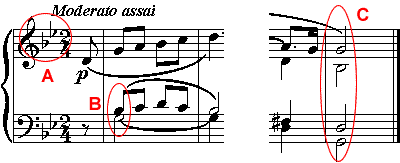Harmonic Functions : Harmonic Analysis
We will now use the concepts we have discussed to analyze a short piece by the Russian composer Pyotr Il’yich Tchaikovsky (1840-1893) called French Song.
The first step is to determine the key of the piece. We should first look at the key signature. In this case, the key signature (a) has two flats, so it is either B flat major or G minor. By looking at the first (b) and last (c) measures, we see that it starts and ends with a G minor chord. We can then conclude that the piece is in the G minor key:

The G minor key can also be determined by the use of the F sharp note in the D major chord just before the last chord. D major is the dominant chord of the G minor key.
Once we know the key of the piece, we can identify chords, inversions, degrees and harmonic functions. Let's take a look at the G minor key's chords. Uppercase Roman numerals are used for major chords. Lowercase Roman numeral for minor chords. The o is used to identify the diminished chord:

In minor keys, the V and VII degrees are commonly altered. As a result, we can have more than seven chords. In this case, we have only used the raised seventh degree in the V and VII degree chords.
Let us now do a complete analysis:

|
||
|
The piece begins with a tonic G minor chord (i), notes in red are chord notes.
Notes in blue are nonharmonic tones, passing tones in this case. See Nonharmonic Tones for more information. |
||
Listen to the complete piece:
Chris Breemer, piano. Courtesy of Piano Society and Chris Breemer.







